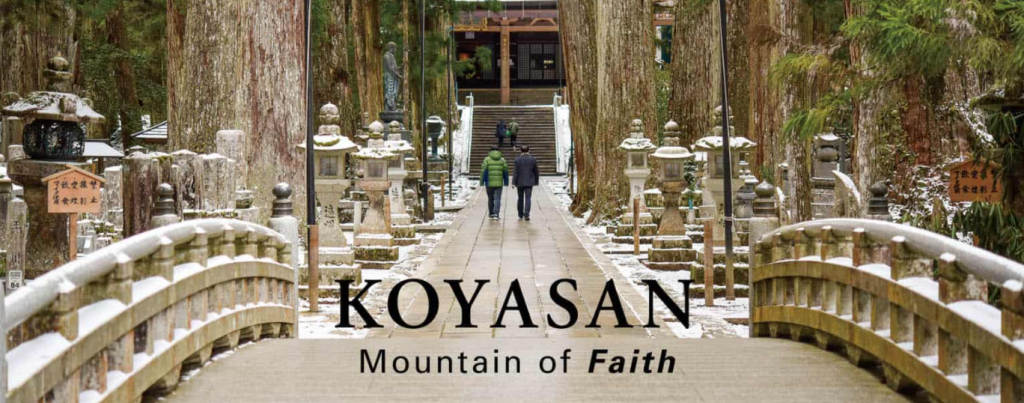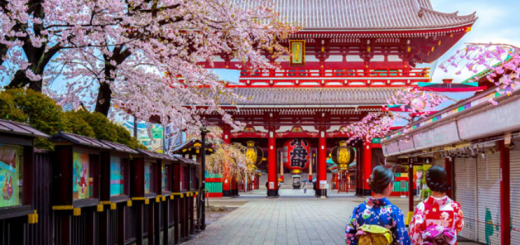Koyasan, the sacred land on top of Mount Koya

In the past, before the accessibility of Koyasan as it is today. People visiting Koyasan must pass through the huge city gates onto the main road leading to the many temples located close together. and has a route linking various temples unite The villagers in that area therefore likened it. Actually, the whole town of Koyasan is like a temple.
There is a large city gate as a temple gate. And the temples are the only buildings that are joined together. The harmony of architecture and the surrounding nature makes it easy to think like that, despite the advancement. Until the city is convenient, including trains, cafes, restaurants, supermarkets. But this place still retains its uniqueness. This small town, if you have time, can walk around. However, local buses run throughout the day as an alternative to sightseeing.
DAIMON
The large, two-story gate, located to the west of the city, was the former entrance to Koyasan City. From the days when we had to walk up the hill without a car. This ancient architecture. It is rebuilt in 1705 because the original one was destroy. It is 25 meters tall. Two large guardian deities, called “Niozo”, stand on either side of the gate. when walking closer will see patterns of wood carvings that reflects the exquisitely beautiful architecture
DANJO GARAN SACRED TEMPLE COMPLEX
The first temple to be built in Koyasan by Kobo Daishi, founder of the Shingon sect. There is a large red pagoda known as Konpon Daito (Konpon Daito). Inside is a statue of Dainichi Nyorai Zazo (Dainichi Nyorai Zazo). Importantly, there are beautiful paintings. It has a distinctive architectural style that has become a symbol of Koyasan City. The pagoda was rebuilt in 1937 after a major fire. It has two floors, 48.5 meters high, 24 meters wide on each side.
There are also important buildings such as the Kondo Church, rebuilt in 1932, and the newly built Chu-mon Gate in 2015. It’s also the 1200th anniversary of Koyasan.
KONGOBUJI
The largest temple in Koyasan Serves as the headquarters of the Shingon Sect. The temple’s building is characterize by a large and tall gable roof. roofing with bark make it look like a powerful temple but very quiet Inside there is a gallery of beautiful paintings on sliding doors that have a profound meaning. There was a lounge for the shogun of old times. to have a small room Let the samurai hide beside him.
Guarded until open to the grand, antique kitchen still in use. With an antique rice cooker for 2,000 people and an antique pantry floating overhead. Most importantly, there was room for the emperor and the royal family. There is a Japanese rock garden in front. This garden is known as the largest rock garden in Japan. Place the stones in the order that represents the 2 dragons guarding this room. which we can walk and admire the beauty around up close
OKUNOIN
The path to enter the temple will pass through an ancient tomb, a distance of 2 kilometers, filled with more than 200,000 stone-carve signs, insert in large trees that are hundreds of years old. Shingon sect devotees believe that this area is a peaceful afterlife because of its close proximity to Kobo Daishi, there have been gravestones of many important figures since ancient times. We can see the tombs of large families or companies. With a stone label carved into a specific shape (such as a Yakult bottle or a UCC coffee cup), it looks unusual and shady. But looking at it from another angle, this is the path to the Dharma that shows the truth of life without even having to speak.
Before entering the temple area, there is a bridge across a small river. It is believe that when crossing this bridge It is the spiritual region of Kobo Daishi. So photography is prohibit and respect is require. A stone walkway leads to a lantern-lit church. Thousands of ceilings. And there is an old lantern that has been lit since 1016 AD that has never been extinguish. The innermost building is Gobyo, the place where Kobo Daishi’s spirit resides. It is said that before he left, he dig a deep pit to meditate for ten days and then left his body. But it is believe that his soul essence is still alive . Here, the atmosphere inside the temple is peaceful and magical. extraordinarily magical


